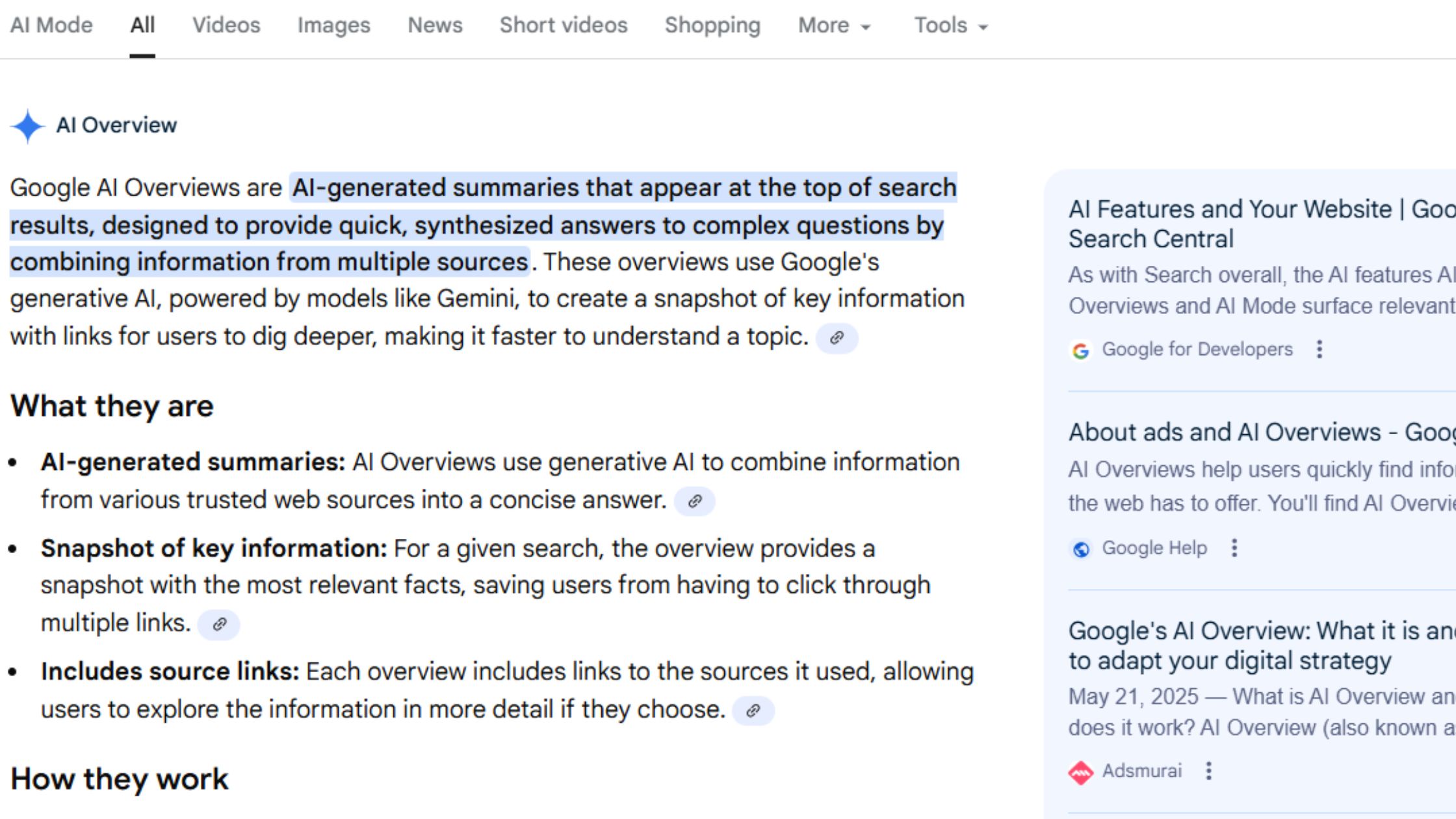When you search for something on Google today, you might notice a block of summarized text, often at the top, that looks more conversational and complete than a typical snippet. That’s Google’s AI Overview in action.
These summaries, powered by generative AI, don’t just show links. They synthesize answers from a small pool of credible sources and highlight them directly within the results.
For businesses, this shift means something major:
Even if you hold the #1 organic position, your content might not appear in the new “answer layer” of search — unless it’s formatted and structured for AI to understand.
In this guide, we’ll explain:
- How Google’s AI Overviews selects its sources,
- What kind of content gets cited, and
- What steps can you take to make your brand visible inside them?
Quick Answer
Google’s AI Overviews cite sources that demonstrate clear expertise, accurate entities, and structured content. Websites with schema markup, concise summaries, and verified information are more likely to appear as trusted references inside AI-generated results.
What Google’s AI Overviews Actually Are (and Why They Matter)
Google AI Overviews are the product of Google’s “Search Generative Experience” (SGE) — a new way of delivering answers through AI-generated summaries. Instead of showing ten blue links, Google’s AI scans its index and generates a short, structured response — then attributes the information to a few reliable sources.
These Overviews pull text, data, and context from multiple web pages to form one coherent summary.
Unlike traditional snippets, which are extracted from one page, AI Overviews combine and cross-verify information from several, often only three to five trusted domains.
That makes the competition fierce. To appear inside one, your content must meet higher standards of clarity, trust, and structure.
Why it matters:
As more users rely on AI summaries, fewer click through to websites. Visibility now depends on being referenced, not just ranked.
How Google Chooses Sources for AI Overviews
Google hasn’t published an exact formula for source selection, but SEO and data studies point to three clear factors: Authority, Entity Clarity, and Structure.
Let’s break these down.
1. Authority & Accuracy
Google’s AI systems pull information from sources they consider reliable.
Authority here doesn’t just mean domain age or backlinks; it means a proven track record of accurate, verifiable, and expert content.
Pages that tend to get cited include:
- Government or educational domains (for factual data).
- Reputable publishers with verified author profiles.
- Brands that use external citations and reference data sources.
- Local or niche experts with consistent coverage on their topic.
What helps:
- Adding author bios with credentials and experience.
- Linking to credible external sources (e.g., official studies or reports).
- Publishing original insights, not rewritten summaries.
Example:
A verified digital agency that publishes its own AI SEO case studies has a stronger chance of being cited than one that reposts trends.
2. Entity Clarity & Topic Alignment
Google’s AI systems use entities, people, places, brands, and topics to understand meaning and relationships.
When your website clearly defines and connects these entities, AI can more easily interpret context.
For example:
“Premiere Creative → AI SEO → New Jersey → Ecommerce” creates a clear semantic chain.
What helps:
- Using schema markup for Organization, Product, and FAQ content.
- Maintaining consistent business names, addresses, and topics across pages.
- Interlinking related articles to form semantic clusters.
When AI can confidently associate your brand with a topic, it sees your site as a reliable data node. That’s what earns visibility in Overviews.
3. Format & Structure
Even the best content can be ignored if it’s difficult for AI to parse.
AI Overviews favor pages that present information in a structured, scannable way.
This means:
- Starting sections with Answer Cards (short, two-sentence summaries).
- Use bullet lists or tables to organize comparisons.
- Writing with clear H2 and H3 headings based on real search questions.
- Adding FAQ sections at the bottom of pages.
Example:
A post that begins with, “AI SEO means optimizing your website so search systems can understand and cite your content” is far more likely to be cited than one buried in long introductions.
Common Traits of Pages That Get Cited in AI Overviews
After analyzing hundreds of AI overviews across industries, certain traits repeat.
Pages that appear frequently inside Overviews often share these elements:
| Trait | Why It Matters | Example |
| FAQ Schema | Let’s AI extract exact question-and-answer pairs | “What is AI SEO?” block parsed directly |
| Answer Cards | Matches AI summary format | 2-sentence intro under each heading |
| Tables & Lists | Easier to interpret than paragraphs | Product comparison tables |
| Entities | Reinforces topic alignment | “Premiere Creative – AI SEO – NJ” |
| Credible Outlinks | Confirms data accuracy | Links to Google documentation or research |
| Fresh Updates | Signals reliability | Updated “2025” content timestamps |
The takeaway:
AI doesn’t pick sources at random. It favors clean, structured, trustworthy content over long, unformatted pages.
How to Make Your Site Eligible for AI Overview Citations
Here’s a practical roadmap any brand can follow to boost its eligibility.
Step 1: Add Schema Markup
Structured data helps AI parse your content accurately.
Use schema types like:
- FAQPage – for Q&A sections
- HowTo – for process content
- Organization – for brand credibility
- LocalBusiness – for regional authority
Validate your markup using Google’s Structured Data Testing Tool.
Step 2: Use Answer-Led Formatting
Think like an AI model, start with the short version first.
For every major heading:
- Begin with a 1–2 sentence “Answer Card.”
- Follow with detail, examples, or supporting context.
- Use bullets or lists for clarity.
This mirrors how generative engines build summaries from structured snippets.
Step 3: Map Entities and Internal Links
AI models don’t just read content, they connect ideas.
Use semantic linking to show topical authority.
This network effect helps AI understand how your content ecosystem fits together.
Step 4: Reinforce E-E-A-T (Expertise, Experience, Authority, Trust)
AI systems factor in the same credibility signals that Google’s human evaluators use.
Boost these with:
- Verified author bios and organization details.
- Real case examples or before-and-after results.
- External citations and supporting data.
Even one or two proof points per post can dramatically improve AI trust signals.
Step 5: Track AI Visibility
You can’t manage what you don’t measure.
Use a combination of tools and manual searches to monitor performance:
- Google Search Console → “Impressions without clicks.”
- Generative AI search testing (SGE Labs or ChatGPT plugins).
- Voice search checks (“Hey Google, what is AI SEO?”).
Log mentions or summaries where your content appears. Over time, this creates a visibility baseline you can optimize from.
Mistakes That Prevent Citation in AI Overviews
Even strong websites can miss out if their structure sends mixed signals.
Here are the most common pitfalls:
- Dense, unscannable paragraphs.
- Missing or invalid schema markup.
- Overuse of promotional or vague language.
- No external citations or supporting data.
- Duplicated or overlapping content within your site.
- Ignoring entity consistency across pages and directories.
Tip:
If your content reads well to a human but lacks logical structure or metadata, AI systems may still ignore it.
Future of AI Overviews (and Why You Should Prepare Now)
AI Overviews are no longer experimental; they’re a permanent part of Google’s search experience.
As AI continues to merge with voice search, shopping, and local discovery, the way users find information will rely even more on machine-selected sources.
Brands that structure their sites for these systems now will have an outsized advantage later.
Being early to AI SEO is like being early to mobile optimization a decade ago; it sets the baseline for all future visibility.
Even if AI Overviews reduce click-through rates, the branding effect of being cited as a source of authority is huge.
Visibility drives trust. Trust drives leads.
Key Takeaways
- Google’s AI Overviews cite pages with clear authority, accurate data, and entity structure.
- Schema markup (FAQ, HowTo, LocalBusiness) increases parse accuracy.
- Formatting your content with short answers, lists, and tables boosts inclusion odds.
- Building entity connections (internal links, bios, consistency) establishes trust.
- The future of SEO is hybrid, part ranking, part recognition in AI-driven results.

